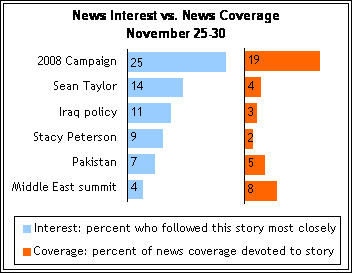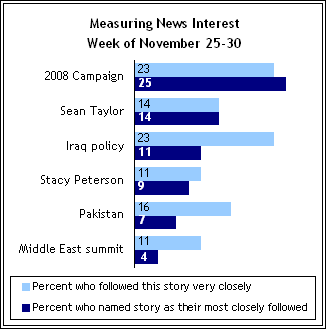Summary of Findings

Even as the 2008 presidential campaign draws increasing news coverage, the public shows limited awareness of the personal backgrounds of some of the top GOP candidates.
While 86% of the public is able to name Rudy Giuliani as the former mayor of New York City, only about half as many — 42% of the public — correctly identified Mitt Romney as a Mormon and even fewer (35%) knew that Romney was the former governor of Massachusetts.
Romney’s speech on religion and politics, scheduled for Dec. 6, is widely seen as an effort to assuage concerns that some religious conservatives in the GOP have raised about his Mormon faith. Among Republicans, 60% could name Romney as the Republican candidate who is Mormon, but 40% could not.
Mike Huckabee, whose support is surging in key primary states as well as in national polls, is still something of a mystery to the public. Only about a quarter of Americans (26%) — and just 36% of Republicans — correctly named Huckabee as a former Arkansas governor. Smaller percentages are aware that Huckabee is a former Baptist minister (21% of the public, 28% of Republicans).
There is greater public awareness of John McCain’s experience as a prisoner of war in Vietnam and Fred Thompson’s background as a TV and movie actor. Overall, 56% of the public named McCain as a former POW while 47% correctly identified Thompson as a former actor.

More Americans say they feel like they know a lot about Giuliani and McCain than the other leading Republican candidates. Even so, fewer than three-in-ten say they know a lot about Giuliani (28%) and McCain (27%). Just 16% say they know a lot about Romney, while 11% say they know a lot about Huckabee. More than four-in-ten Americans (42%) say they know “nothing at all” about the former Arkansas governor.
As expected, the GOP candidates are better known by Republicans than by Democrats or independents: 39% of Republicans know a lot about Giuliani and 38% know a lot about McCain. However, even among Republicans, only 29% say they know a lot about Romney. Fewer than one-in-five Republicans know a lot about Thompson and Huckabee, with 39% saying they know nothing at all about Huckabee.
These findings are based on the most recent installment of the weekly News Interest Index, an ongoing project of the Pew Research Center for the People & the Press. The index, building on the Center’s longstanding research into public attentiveness to major news stories, examines news interest as it relates to the news media’s agenda. The weekly survey is conducted in conjunction with The Project for Excellence in Journalism’s News Coverage Index, which monitors the news reported by major newspaper, television, radio and online news outlets on an ongoing basis. In the most recent week, data relating to news coverage was collected from November 25-30 and survey data measuring public interest in the top news stories of the week was collected November 30 — December 3 from a nationally representative sample of 1,005 adults.
Campaign Tops News Interest Index

The presidential campaign was the most heavily covered news story last week, with much of the coverage focused on the Republicans’ YouTube/CNN debate. More than half of the public (56%) say they either watched the debate (15%) or heard or saw news reports about it (41%). This is comparable with the proportions of the public that watched or heard about the Democrats’ YouTube debate in July.
The campaign was by far the public’s top news story last week: 23% followed campaign news very closely and 25% listed the presidential campaign as the single news story they followed more closely than any other. In spite of the media’s heavy focus on the race for the Republican nomination, Democrats and Republicans followed the campaign in roughly equal proportions.
The shooting death of NFL player Sean Taylor also drew considerable public interest. Overall, 14% named Taylor’s death as their top story of the week. More than twice as many African Americans as whites paid very close attention to Taylor’s story (29% vs. 12%). Fully 26% of blacks named the Taylor story as their most closely followed news story of the week, putting it on par with the presidential campaign. In addition, more men than women tracked this story very closely (19% vs. 11% of women).

By contrast, women were more interested than men in news about the missing Illinois woman Stacy Peterson. About one-in-seven women (15%) followed this story very closely, compared with 7% of men. While the Peterson story attracted 2% of news coverage overall, the broadcast networks devoted 6% of their newshole for the week to Peterson’s disappearance, making it the fourth most closely followed story on that sector.
About a quarter of Americans (23%) say they followed news about the Iraq policy debate very closely, while fewer paid very close attention to news about Pakistan (16%) and the Middle East summit in Annapolis, Md. (11%). When people are asked to name the story they followed most closely, 14% named reports on Taylor’s death, while 11% named Iraq policy. Smaller numbers cited either developments in Pakistan (7%) or the Middle East summit (4%) as their top story of the week.
About the News Interest Index
The News Interest Index is a weekly survey conducted by the Pew Research Center for the People & the Press aimed at gauging the public’s interest in and reaction to major news events.
This project has been undertaken in conjunction with the Project for Excellence in Journalism’s News Coverage Index, an ongoing content analysis of the news. The News Coverage Index catalogues the news from top news organizations across five major sectors of the media: newspapers, network television, cable television, radio and the internet. Each week (from Sunday through Friday) PEJ will compile this data to identify the top stories for the week. The News Interest Index survey will collect data from Friday through Monday to gauge public interest in the most covered stories of the week.
Results for the weekly surveys are based on telephone interviews among a nationwide sample of approximately 1,000 adults, 18 years of age or older, conducted under the direction of ORC (Opinion Research Corporation). For results based on the total sample, one can say with 95% confidence that the error attributable to sampling is plus or minus 3.5 percentage points.
In addition to sampling error, one should bear in mind that question wording and practical difficulties in conducting surveys can introduce error or bias into the findings of opinion polls, and that results based on subgroups will have larger margins of error.
For more information about the Project for Excellence in Journalism’s News Coverage Index, go to www.pewresearch.org/journalism.


